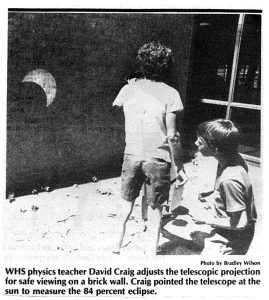 I covered my first eclipse in 1984 working for a local paper in Austin, Texas. I didn’t have a 300mm lens back then. I didn’t even have a 70-200 f/2.8. Maybe an f/4 telephoto. But it didn’t matter. I wasn’t there to compete with NASA, I was there to get a photo for the local newspaper.
I covered my first eclipse in 1984 working for a local paper in Austin, Texas. I didn’t have a 300mm lens back then. I didn’t even have a 70-200 f/2.8. Maybe an f/4 telephoto. But it didn’t matter. I wasn’t there to compete with NASA, I was there to get a photo for the local newspaper.
I sought out my high school physics teacher, David Craig, who I knew would be planning something. Indeed, he had. He set up a telescope outside the school and projected the image through the telescope on to the wall of the school. Interesting photo, that, most of all, told a story.
Andrew Davidhazy, a frequent ATPI speaker and retired RIT professor, reminded photographers that this next total eclipse that can be seen from the contiguous U.S. will be on Aug. 23, 2044 — more than 20 years from now. PATH OF THE 2024 ECLIPSE
“Take a few seconds to enjoy looking at the eclipsed sun besides spending time photographing and missing the real thing. I’m not sure how long the eclipse will be at anyone’s location but it ranges from very brief to a few minutes.”
SAFETY
One of my teacher friends was planning coverage of the eclipse with her students. She commented that she would spend half of her time passing out safety glasses and the other half of the time telling students NOT to look directly at the sun without special filters or glasses.
As NASA recommends, “When watching a partial or annular solar eclipse directly with your eyes, you must look through safe solar viewing glasses (‘eclipse glasses’) or a safe handheld solar viewer at all times. Eclipse glasses are NOT regular sunglasses; regular sunglasses, no matter how dark, are not safe for viewing the sun.”
Davidhazy said, “While eye safety is important, equipment safety is also important. Don’t aim the camera at sun for any extended time. You may permanently damage the sensor. Also, shoot through a solar filter.”
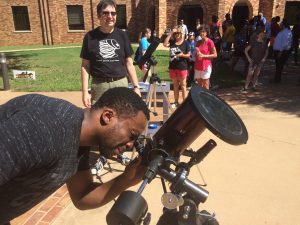
Students and faculty viewed the 2017 eclipse through a telescope equipped with a special filter. Photo by Bradley Wilson
Without glasses, view the eclipse as Craig did — projected through a telescope.
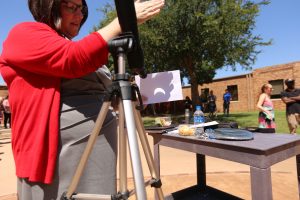
Margaret Brown Marsden projected the 2017 eclipse through a telescope. Photo by Bradley Wilson
Another way to safely view the eclipse is projected through any small hole.
As Davidhazy said, “Pinhole openings in leaves of trees will cause crescent shaped shadows (well, not shadows but the inverse). on the ground.”
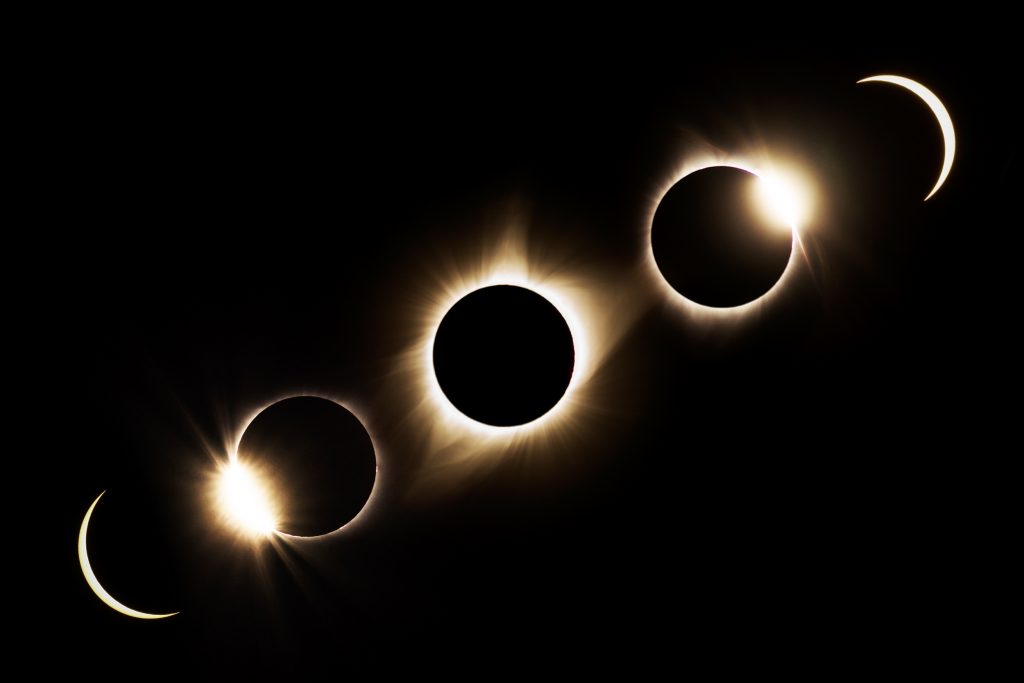
Digitally constructed image from 2017 by Everest Maher, Westlake High School (Austin, Texas), Alison Strelitz, instructor.
Shooting the eclipse itself
Even for experienced photographers, shooting the eclipse itself is a challenge. There’s almost no way to practice shooting it and it will only last a few minutes at best. The maximum duration of totality anywhere along the eclipse path will be 4 minutes 28 seconds. Taking pictures in total darkness is always a challenge requiring special equipment and skill.
A critical piece of equipment for shooting the actual eclipse will be a special filter. Do not stack neutral density filters. The minimum strength for a solar filter is 16-stops. These filters are not cheap and are getting increasingly hard to find.
Davidhazy said, “Once the eclipse is almost total remove the filter from the camera and shoot normally. I think autoexposure on the camera should work.”
Shooting the eclipse itself will require a long lens, a 300mm lens at least. A 300mm lens with a 2x teleconverter (yielding a 600mm lens) will help fill more of the frame with the celestial event. The size of the image of the sun on the camera’s sensor is roughly 1/100 the focal length of the lens on the camera so a 600mm lens will produce an image of the sun that is 6mm.
“With long focal length lenses there will be noticeable movement of the sun in the camera’s viewfinder,” Davidhazy said.
Handheld exposures should be fine with the partial phases when the whole or part of the sun is covered. During totality a photographer may have to use longish exposure times and hand-holding becomes problematic.
Exposures during totality will be longer and might require substantially higher ISO settings.
Davidhazy said, “I’d suggest bracketing exposures during totality as the corona spreading out from the sun is bright to faint. Enterprising students may try to do a sequence starting from before to after totality. I guess this can be done on separate exposures and then assembled into a stream later.”
READ MORE “Solar Eclipse Photography” by Fred Espenak, NASA
READ MORE “How to Photograph a Total Solar Eclipse” by Fred Espenak
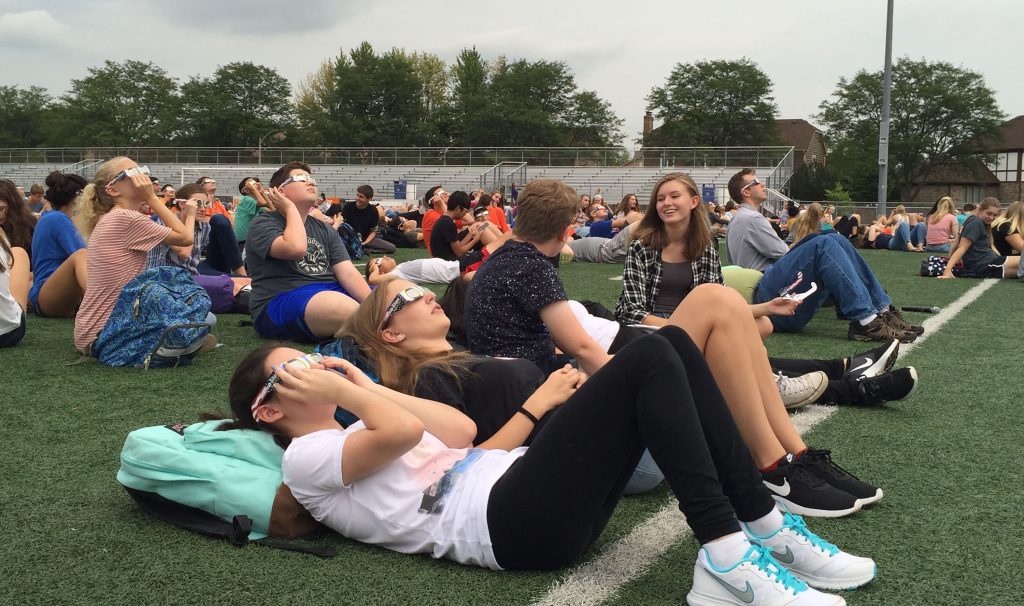
Digitally constructed image from 2017 by Caroline Stiefbold, John Hershey High School (Arlington Heights, Illinois).
Stiefbold said, “I learned that what I expected to be happening at this event didn’t occur. I thought students would be sitting in the bleachers. Instead, they were lying on the football field so I had to change my vision. Our coverage ended up being better than expected because our visuals took an unexpected, positive turn, and students’ excitement about the eclipse led to a lot of readers checking out the story.”
Reporter Lauren Theisen said, “It was hard to judge things based on something that I haven’t seen before.”
Shooting the reaction
While the eclipse itself will certainly be an event worth watching, particularly for scientists, the real story for scholastic photographers will be how students, faculty and staff engage with the eclipse. The reaction and the interaction will warrant lively student life images and coverage in print, online and on social media. Photographers might even have a group compile images for an exhibit later in the year.
Many students and faculty got a taste of covering a solar eclipse back in 2017. Paul David Delos Santos, instructor at Chaparral High School (Las Vegas) said, in a 2017 article in Communication: Journalism Education Today, that they did learn some important lessons.
“The important lesson to learn: When covering an event, the staff must be aware that circumstances may change,” The unpredictable can produce interesting stories as well as the expected results. The circumstances also illustrated the importance of communication between staff members.”
MORE INFORMATION
Join photographers and educators Gabriel Biderman and Matt Hill from National Parks at Night to learn how to photograph solar eclipses. VIEW THEIR VIDEO HERE
CLICK HERE to download an article from the magazine of the Journalism Education Association on the 2017 eclipse.
FEATURED PHOTO by Libby Mullican, Mill Valley High School (Shawnee, Kansas)
Thoughts on the 2017 eclipse from KATHY HILL HABIGER, MJE, adviser, Mill Valley High School (Shawnee, Kansas)
It’s hard to plan for something no one has ever experienced. We decided early on not to worry about photographing the actual eclipse. We left that to the professionals. We decided to extend our coverage beyond our high school to nearby elementary schools to have more photo opportunities and to showcase how the district was using the eclipse as a learning opportunity.
We also tried to anticipate the camera settings for each point during the viewing. For example, it was supposed to be nearly night during totality so that was tricky to plan for.
The biggest thing the students learned is that Mother Nature is not kind sometimes. Cloudy weather for a solar eclipse is not what we planned on or hoped for, but it is what we got. The photographers learned that no matter what, you keep shooting. Students did not have much to look up at consistently during the viewing time, but the photographers took photos of whatever students were doing, including playing games with their classmates or simply hanging out and waiting. The photographers felt special about shooting something that most people experience only once in a lifetime, and they were proud to post the story and photos on deadline on our website so that the community could see how the district handled the event and what our students experienced that day. We also have nearly everything we need to produce the yearbook spread about the eclipse.
VIEW their online coverage.
ATPI ECLIPSE CONTEST
This photo contest is open to any scholastic (grades K-12) photographers and their instructors.
Entry fee:
- $0 for ATPI members and students of ATPI members
- $20 for non-ATPI members and students of non-ATPI members (which pays for membership and as many student entries as desired) JOIN HERE.
- Submit entries HERE after April 7, 2024
Student categories:
Students can enter one or two images in each category. There is no limit on the number of students per school that can participate.
- Reaction to the eclipse
- The eclipse (including reflected and projected images of the eclipse where the image is primarily of the eclipse itself, not people and their reaction to the event)
Faculty categories:
Faculty can enter one or two images in each category.
- Reaction to the eclipse
- The eclipse (including reflected and projected images of the eclipse where the image is primarily of the eclipse itself, not people and their reaction to the event)
Deadline:
- Entries must be uploaded into the ATPI system on or before 6 p.m. Central Daylight Time April 24
- The eclipse is April 8, 2024, the last one for 20 years
- Submit entries HERE after April 7, 2024
Awards:
- ATPI will award first, second, third and as many honorable mentions as are warranted in both the student and faculty categories
- In addition, ATPI will award best of show for student and a best of show for faculty
- This contest will count for points for the ATPI Imagemaker Team
- Selected images will be published on ATPI social media, ATPI.org and in the national magazine of the Journalism Education Association — Communication: Journalism Education Today

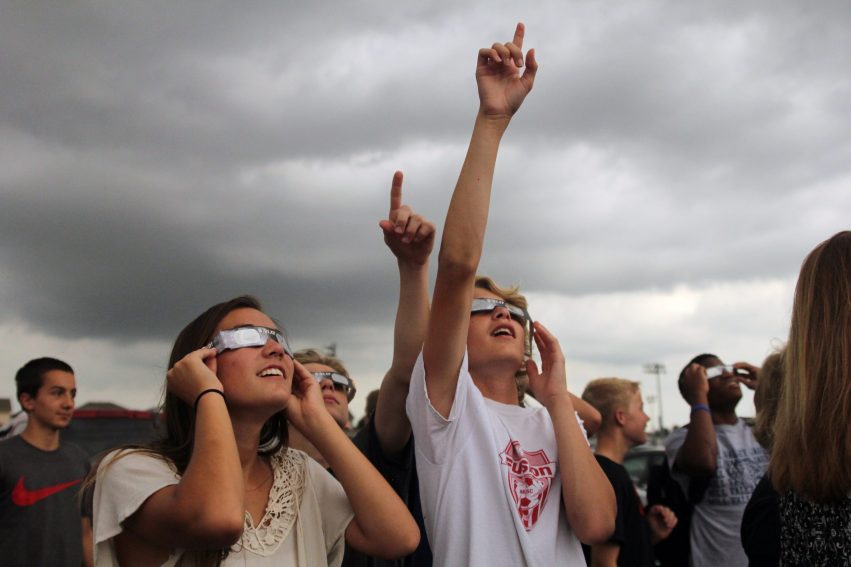
Pingback: The Great Solar Eclipse of 2024: Capture It in Your Yearbook! | Yearbook Spreads